The concept of 'mal-de-ar'** held by the 'sons of the earth' (1) is possibly one of the most illustrative examples of how cultures can come together and traditions with shared ancient roots can survive amongst the ordinary people.
In the 1970's the older generation of Macanese had several explanations for mal-de-ar. This would seem to indicate that various interpretations of this kind of symptom came together at some point in the territory's distant past.
For some of them, mal-de-ar was an illness caused by a current of air and thus had a natural cause. For others, perhaps the memory of ancient Malayan beliefs made them think it was ar maligno or savan (see note 15). Ar maligno is a nervous complaint which manifests itself through anxiousness, delirium, rheumatism and even facial paralysis and torticollis if there is any damage to the blood vessels in the brain.
There is another interesting view of this complaint which coincides with the end results but differs in the cause. Furthermore, the situation is confused by the fact that the Chinese call this cha lap fong meaning 'impure wind'.
'Impure wind' can produce similar effects as savan. In some ways it corresponds to the 'arrow wind', a wind which is opposed to fong soi (Ed. Note: see articles on this subject in this issue) and which can come from wind channelled through a hidden alleyway, from a badly placed door or from any strange wind which stirs up the dry leaves on the streets, especially in the corners. The original idea of this ma-de-ar has been lost in the Chinese community, even amongst those who are most conservative. The Chinese are afraid of 'impure wind' and are convinced of its effects. They do not, however, know how to explain it unless through fong soi and obstacles which can prevent good fong soi, such as a large house placed in front of a little one, thus blocking the sunlight, any building which is not in harmony with the surrounding ones or the influences of wandering 'evil spirits'.
The mix-up between mal-de-ar 'impure wind' and savan which is obvious in the Macanese community, must come from the Indo-Malayan belief (also common amongst the Chinese) that the dirty air which emanates from a drain, a dead rat or decomposing organic material in general can induce more or less supernatural illnesses which are extremely difficult to cure. Thus mal-de-ar, 'impure wind' and savan are characterized by chronic headaches, feeling 'under the weather' and exhaustion, always occurring at the same time on successive days.
The Macau community is unanimous about the origins of mal-de-ar, savan(2), and 'impure wind': it can come from a current of air or even bagate. (3) It is also worth noting that there are very similar concepts throughout the world.
Some groups which have remained fairly isolated, for instance some communities living in the Andes, can shed some light on how these ideas actually began. The Kallawaya, a Bolivian group of itinerant healers, whose knowledge dates from ancient times and has been transmitted from generation to generation, divide illnesses into two main groups:
- those with natural causes
- those with magical causes
They subdivide the latter group into those which are caused by spirits stealing a soul, thus provoking mal-de-susto, and those which are caused by a spirit which enters the body and replaces that person's soul. This can cause fairly severe paralysis known as doença-de-ar(4).
The Kallawaya believe there are several kinds of spirits which can cause illness such as earth spirits, water spirits, mountain spirits, fountain spirits, air spirits, thunder spirits and so on. (5) Of all the evils wrought by these spirits, the most frequent is not, however, mal-de-ar but rather mal-de-susto. What is particularly interesting is that the Portuguese in Macau believe in absolutely the same complaints as the Kallawaya, the similarity being evident even in the names they give them.
All the groups living in the Andes believe, as do many conservative Chinese, that people have more than one soul. The double spirit can live on in the form of the person after death, while an evil spirit becomes a ghost which can harm the living.
In addition to these two souls, there is one called the agayn which protects physical well-being. If this is stolen or replaced by another spirit, it can create a lack of inner harmony which could prove to be fatal.
Less troublesome than having one's soul actually stolen or replaced by a powerful spirit, is for it simply to get a fright. This happens frequently and is benign in children, whereas for adults it is a much more serious problem which can cause mal-de-susto.
Of all the illnesses which can be caused by a spirit entering the body, mal-de-ar is the one most feared by people living in the Andes. The Andean people also believe that the development of a fetus can be affected if the pregnant mother sees the body of a dead animal or human being during gestation. This accident is also much feared by the Malaysians and Macanese. They extend its effects to everybody and regard it as the most important cause of savan.
The concept of mal-de-ar in Europe is also deeply rooted in ancient traditions and was formerly included in classical medical practices. From this, it spread to the common people who still keep it alive in some areas. Strangely enough, it is also connected to the practice of magic. (6)
According to Ralph Bluteau (7), in the sixteenth century mal-de-ar was regarded as the same complaint as parlezias. In many Portuguese villages this is still given as the cause for a series of illnesses of varying degrees of severity which appear suddenly for no apparent reason. It is quite common to hear somebody saying "It was an air he caught..." when there is a sudden change in the state of health of any person.
In the Alentejo, for example, it is quite common to come across the idea that apoplexy can be treated with the appropriate prayer for "blessing the air caught in the head". In some villages in the South of Portugal people believe that apoplexy is caused by an evil current of air which can come from another person. (8) They then say that person "gave him the air", an expression which is also used to indicate that somebody is suffering from apoplexy which could develop into partial paralysis or even be fatal. (9)
This view was shared by elderly people living in Macau in the 70's, particularly with regard to the 'impure wind' of Chinese origin and the clearly Portuguese concept of mal-de-ar.
Ar savan, vento sujo and olhado are frequently confused in Macau. This confusion is particularly obvious when we look at the treatments given for each complaint. Prayers and sung blessings are not used for anything except mal de susto when children are being exorcised. Nevertheless, remedies for savan are usually used as much for 'impure wind' and olhado as for savan.
This confusion about savan was especially evident amongst the ladies of Macau. Some of them identified savan with 'impure wind', explaining that the latter was the bad smell which came from a drain, a decomposing body or a dead rat. Others, however, attributed it to the presence of a pregnant or menstruating woman, enough, they believed, to cause mild childhood diseases such as measles, or to prevent a cake from rising in the oven, or even to give a child scabies.
This belief is shared by the Portuguese. However, the Macanese ladies go one step further. They think that savan can cause loss of appetite, headaches and fever occurring always at the same time of day, and even a complete breakdown. It can also cause envy and other related weaknesses. These symptoms are exactly the same as those for olhado found in Portugal. Some famous Portuguese doctors believed in these complaints in the past and produced page upon page of superstitious nonsense. (10)
An example of this kind of outpouring can be seen in the following excerpt: When one sees something dirty such as a corpse which exudes foul smelling substances (11), or when one finds a dead or disembowelled rat, it is possible to catch 'savan'. The patient will experience headaches, pains, fever and weakness and a general sensation of feeling unwell every day at the same time as the cause of the sickness was seen. This can be fatal. (12)
There are also people who speak of savan as being caused by bagate (having a spell cast over one). In this case, a person consults a man heong po(13) who will cast a spell over the person in question. The spell can only be undone by a man heong po with greater power than the first one. These women use prayers and methods known only to them and, once the spell is cast, the exorcisms used for common savan will be of no effect.
Savan is caused by mau ar, mau cheiro, 'impure wind' and olhado although it can manifest itself in many different ways. The frequency with which the term savan appears in use in Macau reflects the very heavy influence of Malayan culture amongst the Portuguese living in the territory. (14)
The expression 'breakdown' was rarely used by Macanese ladies as a synonym for olhado. The interesting thing is that the Chinese also believe in a kind of olhado, something they call seong ngan (double look). This is also due to the influence of a pregnant woman, as is the case with the South American Indians mentioned above and other groups throughout the world.
Mau olhado corresponds to the Latin fascinum (spell, enchantment) and seems to be a universal concept. Because of this, it is not surprising that in Macau people have added different ideas and ritual practices concerning this much feared negative influence.
In Macau there is the Chinese 'impure wind', the Malayan savan, the western mau ar and other concepts originating in Malacca, India, China and Portugal. The cultural exchange which took place in Macau meant that a large number of remedies for these complaints was available, each one suitable for all the other complaints, each one used regardless of which complaint it had purportedly been prepared for.
SOME HOUSEHOLD REMEDIES FROM MACAU USED IN TREATING OLHADO, SAVAN AND 'IMPURE WIND'
Remedies for Mal de Olhado
Mal de olhado can usually be distinguished from savan as it does not cause fever. To treat it, the body must be bathed in an infusion of sprigs of Aster garlachii Wall., while a teaspoon of the same liquid is given orally at the same time. The body should be wiped all over with a cloth, preferably early in the morning or, if this is not possible, at dusk. To wash a boy, seven sprigs or leaves should be used while to wash a girl the amount should be changed to eight. (15)
Remedy for Olhado
Use Aster garlachii Wall. or variegated Senecio pseudochina L. or Gynura segetum Lour. Merr. with the leaves from a grapefruit tree, or else use the seven different leaves which make up 'seven-leaf tea'. (16) The leaves should be ground down and made into one or two poultices to be placed on the wrists. If the complaint is not very severe, one should be enough. Paper should then be wrapped around the wrists. When the poultice dries, it will peel off and the individual will no longer have any 'impurities'. This practice is somewhat similar to the famous 'poison' stones used in villages in the North of Portugal to counteract the effects of olhado, savan or mau ar.
Remedies for Mal-de-ar and Olhado
In XVIth and XVIIth century Portugal there were many remedies for unexplained headaches, sometimes defined as mau olhado. A particularly strange remedy consisted of cooking rue, rosemary, lavender and Galician camomile in a new pot with coloured cloths boiled in the same water. These cloths were then applied steaming hot to the whole head, two or three times. (17)
Another remedy was to use incense sticks placed in burners in order to expel evil airs and spirits from the body. This practice was quite common in Macau, even as late as the first half of this century.
Remedies for Savan
According to a notebook of recipes for meals and medicines dating from the last century and which now belongs to Mrs. Hermínia Figueiredo (18), there are three kinds of popular remedies for savan in use in Macau: those for drinking, those for poultices (19), and those for burning.
For drinking:
"Seven sprigs from the plant Aster garlachii Wall., and one sprig of basil."
For poultices:
"Three sprigs from the peach tree, three small variegated leaves, five sprigs of rue, five sprigs from the Aster garlachii Wall., one sprig of basil, one sprig of mint, three twigs of Eupatorium chinense L., four pinches of black beans, five blessed twigs (20), one pinch of salt, three slices of ginger, three cloves of garlic, pumice stone, incense and St. Francis' feather." (21)
For burning:
"Include all the above-mentioned ingredients except ginger and garlic and add powdered saffron (22), brown sugar and soap. Also put in rice water to let more steam come out."
In another old notebook there is this recipe for treating savan:
"Dried banana peel (for drinking). The infusion of the ashes of the banana peel boiled in water is one of the drinks for curing savan. The ashes should be obtained in the flame of a candle." (This recipe was provided by Camila Grill Guterres of Japan).
This remedy was written in the last century and uses a very interesting term for 'banana'. The banana is described as a 'villain', or 'villain fig' as it was known in Macau. In fact, the peeled banana, cut twice lengthwise, is dried and then used for more or less magical purposes, including exorcism.
Other remedies for Savan passed down by word of mouth:
1. Place black beans, pumice stone and seven sprigs of Eupatorium chinense L. in a muslin bag and crush the contents. Press the bag against the forehead, especially on the temples and between the eyebrows. This remedy is a simple version of the one above, which can be explained by the fact that it has been passed down orally.
2. Grind together pumice stone, rue and black beans and make a poultice to press against the temples to relieve headaches. This is also a remedy for migraine headaches.
3. For 'air' headaches, reduce pumice stone to a powder and mix with rue, lavender and ginger and leave on the forehead. If the mixture turns to liquid, this is a sign that the headaches are caused by savan or 'impure wind'.
4. Basil boiled in half a litre of water can be used for inhaling the steam escaping from a gargú(23) with a towel placed over the patient's head. A towel soaked in this water, then squeezed out, rolled up and placed successively on the wrists, elbows and ankles is also very effective in curing savan. This liquid can also be used for bathing or passing a cloth over the face and the neck at the same time every day, usually at dusk.
5. To prepare an inhalation for Savan, place a little vinegar and water in a pan and let it boil with seven leaves from the Eupatorium chinese L. plant in a bain-marie. The patient must inhale the mixture for three successive days and always at the same time of day, taking care not to do it in broad daylight. Nine or ten o'clock in the morning and five o'clock at night are the best times to do this. If it is done at any other time, it will not be as effective.
For exorcising or 'fumigating':
1. For treating Savan, roast some rice with grapefruit leaves and let the patient inhale the vapours. This kind of treatment was very common in Macau, not only for savan but also for getting rid of mould and stale air by letting the fumes pervade the entire house. Aromatic smoke was long used as the predecessor to modern air fresheners.
2. Benjamin balsam shaped into a black cone is one of the ingredients of the aromatic blocks which were used in churches to perfume the air. Benjamin balsam was also burnt alone at home, as it was regarded as good for perfuming the inside of the house and getting rid of bad moods. (24) It was often the custom to add some lavender or 'cologne'. (25)
Fumigations with rue, lavender and incense were also commonly carried out in Brazil every Tuesday and Saturday morning at each corner of the house to protect it from the 'evil eye'. (26)In Brazil, incense, benjamin balsam, lavender, rue and white resin were mixed together to produce the fumes.
In Macau, it was quite common to air the four corners of each room with different aromatic mixtures which almost always included pumice stone, employed by the Chinese for magical purposes.
3. If a child is suffering from savan, which it may have caught while seated on the lap of a pregnant woman or when a pregnant woman touched it, burn together alum, rosewood (27) grapefruit and wormwood (28) without disturbing the mixture while it burns. If this is the case, then a piece of clothing belonging to the person who caused the misfortune in the first place must be thrown onto the fire.
There are also remedies which involve bathing to cure mal-de-ar, savan and 'impure wind'. These are called scented baths and are very popular in Brazil. The ingredients used in these baths are almost always the same as those used for inhalations.
The most popular treatment for savan is seven-leaf tea. This can either be drunk or else used for bathing before dawn or just after sunset. Some people say that seven-leaf tea corresponds to the Chinese seven-star tea (29) and it is true that there are many variations, some of them clearly influenced by the Portuguese.
It was common practice in XVIIth century Portugal for healers to offer 'seven kinds of smells' to the devil (30), a procedure which was probably related to the famous seven-leaf tea found in Brazil and Macau.
It is interesting to note that the number seven is a highly significant number, heavily laden with magical connotations dating back over thousands of years. It appears frequently in the Bible and in folklore throughout the world. Seven in itself contains magical properties which make it an ideal choice for preparing any kind of remedy for supernatural complaints. (31)
Seven-Leaf Tea
An infusion is prepared from this tea to treat savan and ringworm, either through imbibing it or bathing in it. It is made of the following ingredients:
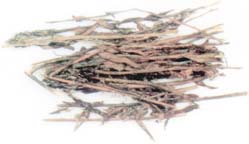
1. Willow leaves (Salix babylonica L.), the hyssop of the Buddhist Goddess of Mercy Kun Iam and also used for magical exorcisms.
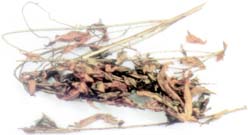
2. Aster garlachii Wall., sometimes replaced by leaves from the peach tree (Prunus persica Stockes).
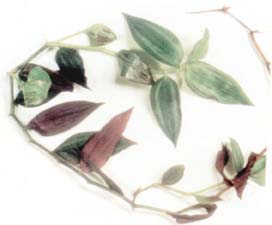
3. Variegated Senecio pseudochina L., or Gynura segetum Lour. Merr..
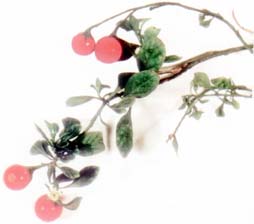
4. Eupatorium chinense L..
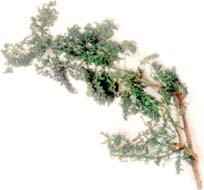
5. Rue (Ruta graveolens L.).
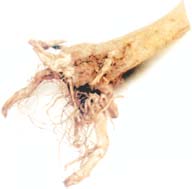
6. Basil (Ocymum basilicum L.) sometimes replaced by mint (Mentha arvensis L.) or Chinese mint (Mentha hirsuta L.).
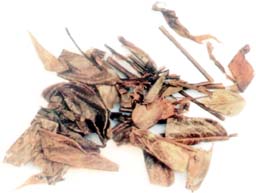
7. Bay leaf, sometimes described as 'prawn paste' (32) leaf locally.
The properties of these ingredients for seven-leaf tea are as follows:
1. Willow leaves. The willow is rich in salicines which are the basis for the ubiquitous aspirin.
2. The fresh leaves of the Aster garlachii Wall. are used in remedies for children and for treating savan.
3. There are several kinds of variegated plants which are suitable for employing in this preparation, including Senecio pseudochina L., Gynura sinuata D. C., and Cacalia bulbosa Lour..
4. Eupatorium chinense L. is good for use as a diuretic and laxative.
5. Rue (Ruta graveolens L.) is used for treating stomach complaints, rheumatism, convulsions and epilepsy. It is regarded as a lucky plant capable of warding off evil influences. In the sixties and seventies it was commonly seen on the balconies of houses in Macau.
6. The young shoots of the basil plant (Ocymum sp.) are used to make teas to aid digestion and settle the stomach.
7. The laurel tree (Laurus nobilis L.) was introduced by the Portuguese. Bay is toxic in high doses but is used as a herb in Mediterranean countries.
Aromatic baths have long been practised in the West. They have some magical connotations and are also used less frequently in treating skin complaints.
Aromatic baths were common in Macau for treating savan. They consisted of wiping the face, hands and feet of the patient with a cloth at sunset. The effects would be heightened if the patient chewed betel leaves and drank tea made from Aster garlachii Hance. at the same time.
Let us now compare the water obtained from making seven-leaf tea, which is used in Macau for treating savan and 'impure wind', with the 'bath for ridding the body of any evil influence' used in Brazil. (33)
The Brazilian bath consists of an infusion of:
3 pieces of straw which have been blessed
1 piece of garlic straw
1 piece of rose laurel
3 clumps of rue
3 bay leaves
3 leaves of Caesalpina ferrea L.
3 sprigs of clover
First, the patient must take a regular bath and then, using the water from this infusion, a second one with three measures of brandy. There are many similarities between the two recipes, not least the fact that they both contain seven ingredients.
I believe that the seven-leaf tea used by the ladies of Macau is simply an adaptation of the seven flavour teas (with Arabic influence) used in Portugal. The Brazilian aromatic bath must also have been adapted from the recipe taken there by the Portuguese.
I should point out that there were some people who inhaled the infusion rather than bathing in it, placing a towel over their head to keep in the vapours.
Various kinds of amulets were also used in trying to ward off savan, the most popular being as follows:
- A whole garlic bulb placed over the navel, hung from the waist or else placed in a pocket. This practice may well have been Portuguese in origin, as there are still people in Portugal who place strings of garlic behind their doors to protect themselves from envy and evil.
- Elephant bristle, or, as it is called in Macau 'elephant whiskers', used in rings and bracelets for much the same purpose as the Chinese wear jade bangles.
There were also some specific remedies for treating savan in children. Instead of burning a piece of clothing belonging to the pregnant woman who caused the savan in the child, in Macau it was customary to steal a personal possession of the person in question. It had to be something small and insignificant such as a handkerchief or a tiny coin. The whole point was that it had been stolen without the woman knowing anything about it. (34) These small objects were then placed in a little bag and hung around the child's neck. It was not uncommon for Chinese maids to ask each other for these items on behalf of their respective mistresses.
CONCLUSION
As we have seen, it is not only the interpretation of mal-de-ar, savan and 'impure wind' which is confused in Macau. The way in which these complaints manifest themselves is also subject to a wide variety of interpretations. However, in the Macanese community it is mostly savan that is accepted as a cause of this kind of complaint.
The ladies of Macau claim that people from Goa also believe in savan and use similar remedies to treat it. To what extent the Indo-Malayan influence on 'impure wind' has been lost, confused with or even influenced by Chinese medical practices is not known at this point. It would also be interesting to know how much Portuguese influence has affected the idea of mal-de-ar in the East.
In Macau the treatments for savan make use of oriental plants, particularly the red or variegated leaves which are so symbolic for the Chinese. Furthermore, Portuguese aromatic plants, particularly those which were commonly used for magical remedies are used. These plants are intended primarily for bathing the patient and are the same as those which the Portuguese took with them to Brazil: basil, mint, balm-mint (35), lavender, rue and rosemary.
The fact that the aromatic baths administered in Brazil contain seven ingredients (36) is also worth noting, leading us to believe that there may have been some cultural crossover between practices in the East and the West, brought about by the Portuguese.
GENERAL BIBLIOGRAPHY
AMARO, Ana Maria: Filhos-da-Terra, ed. ICM, Macau, 1988.
AMARO, Ana Maria: Medicina Popular de Macau, ed. ICM, Macau, (in preparation).
ARAÚJO, Alceu Maynard: Medicina Rústica, São Paulo, 1959.
BENTHAN, G: Flora Hongkongensis, London, 1861.
BLUTEAU, Mons. Raphael: Vocabulario Portuguez e Latino..., Coimbra, 1713-1721.
CASCUDO, Luís da Câmara: Folclore do Brasil, ed. "Fundo de Cultura", Rio de Janeiro, 1967.
COELHO, Adolfo: "Ethnografia Portugueza" in Bol. da Soc. de Geografia de Lisbon, 2nd series, IX and X, ed. Imprensa Nacional, Lisbon, 1881.
LOUREIRO, Fr. João de: Flora Cochinchinensis... 1740.
ROQUE, Joaquim: Rezas e Benzeduras Populares, ed. Minerva Comercial, Beja, 1946.
VELLARD, J.: "Une Éthnie de Guérisseurs Andins..." in Terra Ameriga, No41, Genoa, December, 1980.
** The expression mal-de-ar and the other names of native complaints have been left in their original language in the absence of any precise translation in English
NOTES
(1) 'Filhos-da-terra'(sons of the earth) is the name by which the Macanese are commonly known. The Macanese are Eurasians of Portuguese descent with a rich cultural heritage arising from the convergence of elements from extremely different ethnic groups which has taken place in the commercial city of Macau over the last four hunded years. (see Ana Maria Amaro: Filhos-da-Terra, ed. ICM, Macau, 1988)
(2) It is worth pointing out that for the Northern Chinese ar maligno and 'impure air' are one and the same thing. They can both cause sudden, unexpected indispositions and illnesses which cannot be diagnosed. Neither can be cured by medicine. For the former, ar maligno is understood to be a spirit which lives in isolated areas or areas where Nature runs wild. In the latter case, the cause is 'contaminated air' which emanates from an infected area such as, for example, a dark musty house which has lain empty for a long time.
(3) The word 'bagate' is Indian in origin and is used in Macau to mean 'spell'.
(4) J. Vellard: 'Une Éthnie de Guérisseurs Andins, Les Kallawaya de Bolivie", in Terra Ameriga, the magazine of the "Associazione Italiana Studi America", Genoa, No 41,December, 1980, p.28.
(5) Although the word 'animist' has lost its evolutionist connotations, Tylor has given it a new meaning, that of 'spiritual beings'. Thus the universe is seen as being activated by the spirits which exist within objects. The spirits of the dead, inanimate beings and natural phenomena are regarded as energies which act on the world which man inhabits and which affect his daily life. These spirits can be regarded as divine or not as the case may be. Those which are constitute an extensive pantheon stratified into a hierarchy.
This is the case with the ancient pagan Chinese cults on which almost all magical activities in Macau are based. The ancestral cult plays a special role in agrarian worship, as farmers were the first group to settle in the basin of the Yellow River. However, this is really more a means of communication between the lìving and the dead rather than a true cult, as the ancestors are not divinities. Only the first ancestor, the First Emperor, can be regarded as being divine, given that he is the Supreme Being. That is why he is referred to as the 'Son of Heaven'.
Mediation between the living and the dead does not always require the modern concept of a priest. The position of priest depends on the circumstances, as in the case of the father or head of the family worshipping his ancestors. The role of professional priest implies someone functioning as a mediator, as can be seen in Macau in the ancestral worship and exorcisms carried out in local temples.
(6) In the papers from the trial of Anna Martins, condemned by the Tribunal of the Holy Inquisition in the XVIIth century, it was said that she "looked as if she believed in witchcraft"..
(7) Mons. Raphael Bluteau: Vocabulario Portuguez e Latino..., Coimbra, 1713-1721.
(8) Joaquim Roque: Rezas e Benzeduras Populares (Etnografia Alentejana), ed. Minerva Comercial, Beja, 1946, pp. 17-18.
(9) "It was that air she caught" is a phrase which reflects just how serious the sometimes fatal 'mal de ar' was considered to be. It is worth noting the astonishing coincidence between the Portuguese expressions 'ar triste' (sad look), 'ar de cansado' (tired look), and 'ar deprimido' (depressed look) which are commonly used in conversation as meaning 'appearance', and the everyday Chinese expression on greeting a friend by saying that he has 'a very serious air about him'. The explanation is quite simple in ancient China where a person's appearance was put down to a 'bad air' which he could have caught on the way, a 'bad air' which could have entered his body in the form of a spirit.
(10) In 1705, Friar Manuel de Azevedo stated that he himself "had been given the evil eye three times and once it was so strong that I knew without a doubt that I had been given the evil eye though I had no fever nor cold and so I went to a person who knew how to get rid of it and so he did, and I reverted to what I had been before" (Friar Manuel de Azevedo: Correcção de Abusos... II Parte - Prymeiro Tratado de Fascinaçam, Olhado ou Quebranto..., Lisbon, 1705).
(11) In the case of certain illnesses in which the corpse can emit foul smells, it was the custom in Macau to drip some candlewax in the navel of the corpse to avoid the smell which could cause 'savan'
(12) The concept of winds and bad smells which can cause illness and death is also common amongst the Kung Bushmen in the Kalahari who were studied by Laura Marshall (1962), quoted by B. Bernardi: Introdução aos Estudos Etno-Antropológicos, ed. 70, Lisbon, 1974, pp. 153-154.
(13) Chinese 'woman of virtue' who devotes her life to magical activities.
(14) The word 'savan' is Malay. According to the XVIIth century Malaicum-latinum dictionary held in the National Library in Lisbon, it means 'malign air'. According to Graciete Batalha, modern dictionaries cite 'savan' as being equivalent to 'convulsions' or 'epilepsy'.
(15) The reason behind these quantities lies in Chinese numerology: odd numbers are 'yang' connected to the male principle, while even numbers are 'yin' connected to the female principle.
(16) See section concerning 'seven-leaf tea'.
(17) Manuscripts in the Library and District Archives of Évora, Codex CXXI d (Miscellaneous) Caderno de Mezinhas dating from the late XVIth century (?), fl. 2-24.
(18) D. Hermínia Figueiredo (Hermínia Maria Gomes de Figueiredo, born in Macau, 8/7/1863), twin of Maria Adelaide and daughter of José Miguel Vitor de Figueiredo (born 28/3/1835), paternal daughter-in-law of Doctor Henrique Caetano Vitor de Figueiredo who was born in Goa on 21/7/1799 and married in Macau on 17/5/1831. (Father Teixeira: Os Médicos em Macau, ed. C. I. T., Macau, Imprensa Nacional, 1967, pp. 60-61.)
(19) Applying poultices has long been a traditional cure in the West. In Macau the poultice was made from a little bag of hot rice mixed with simple vegetable medicines or ground alum.
(20) In the sixties and seventies, the 'blessed twigs' were the palms taken to church on Palm Sunday. The number 'five' is reminiscent of the way in which other plants are still used in Portugal where twigs of five different plants (rosemary, lavender, olive and other aromatic plants in place of the lavender) are used to make the 'blessed twigs'. Both in Macau and Portugal, small bunches of these twigs were burnt or hung on the wall during thunderstorms for the same purpose.
(21) It seems that 'St. Francis' feather' is the bud of the reed grass (Phragmites communis Trin.). The rhizome of this plant is used in Chinese medicine. The feather-shaped buds are very attractive and as they were very common in the marshy area behind the St. Francis Convent the name 'St. Francis' feather' was given to them. They are used as an antipyretic, anti-emetic and refrigerant to the stomach. It has not been possible to prove this identification, as the plant cannot be found in the above-mentioned area and the majority of sources claim that they have never heard of it described in that way.
(22) Saffron, which floats when put in boiling water and ground into a fine powder after being dried.
(23) Clay pot used for preparing household remedies.
(24) In my opinion, these fumigations, heavily influenced by the Portuguese, are also influenced by the Chinese belief that ar maligno can build up in large, badly-lit, musty houses.
(25) The term which used to be applied to lavender oil in Macau.
(26) Luís da Câmara Cascudo: Folclore do Brasil, ed. Fundo de Cultura, Rio de Janeiro, 1967.
(27) Rose apple (Eugenia jambos L.).
(28) Artemisia absinthium.
(29) The recipe for 'seven star tea' which I encountered amongst the Chinese population is quite different from the one for 'seven-leaf tea' used by the Macanese community, thus giving rise to this apparent confusion.
(30) The sentencing of Catharina Jorge in 1696 by the Coimbra Inquisition, Sent. I, 263) cited by Adolfo Coelho: "Ethnografia Portugueza", III, in Bol. da Soc. de Geografia de Lisboa, 2nd series, IX and X, ed. Imprensa Nacional, Lisbon, 1881 p.650.
(31) The number seven is regarded as highly significant by astrologers and alchemists, as it represents the number of plants and metals which correspond to the stars: gold-Moon; silver-Moon; tin-Jupiter; copper-Venus; lead-Saturn; iron-Mars; mercury-Mercury.
These mythical parallels between plants and metals have widened to include the seven colours believed to be natural in the Ancient World, the seven transformations of the Judaic-Christian tradition and so on.
There are seven wonders of the world, the Virgin Mary underwent seven trials, there are seven mortal sins, and Seven Saints. The symbolic value of the number seven is very similar in the East and the West.
(32) Prawn paste is prepared from ground, seasoned prawns which have been dried in the sun and flavoured with bay leaves. The bay leaf reflects Portuguese influence.
(33) Luís de Câmara Cascudo: Folclore do Brasil, ed. Fundo de Cultura, Rio de Janeiro, 1967, p.231 citing traditions from Belém.
(34) In Portugal, in the Alentejo region for instance, there are people who believe that a stolen plant will take root better than one which is given.
(35) In Macau, lemon-scented verbena is replaced by balm-mint, which was formerly grown extensively in window-boxes and orchards.
(36) Alceu Maynard Araújo: Medicina Rústica (São Paulo, 1959, pp. 153-4), and Luís da Câmara Cascudo: Folclore do Brasil (ob. cit., p.231).
* Lecturer in the Anthropology Department of the Institute of Social and Political Sciences (Lisbon); researcher at the Centre for Oriental Studies in the Fundação Oriente (Portugal) and holder of a scholarship from ICM. She has published a significant amount of work concerned with Macau's Ethnography.
start p. 27
end p.